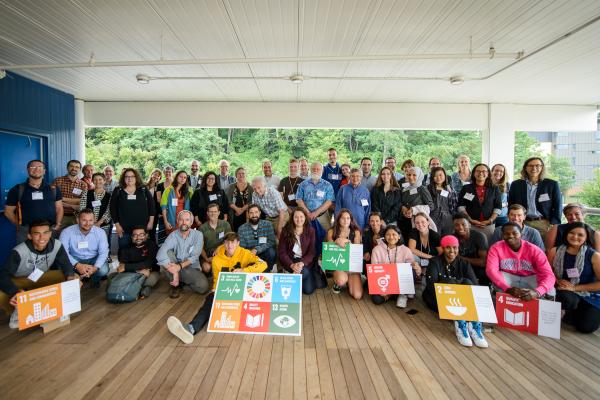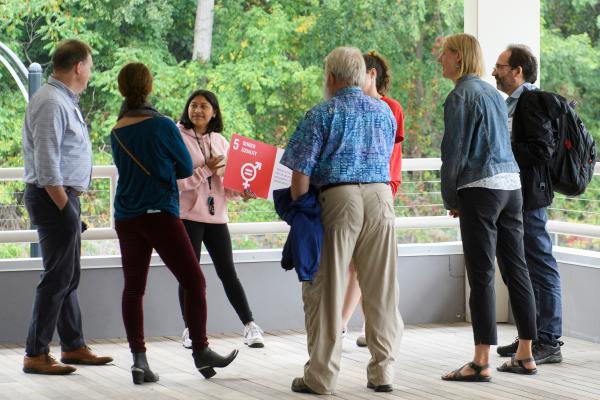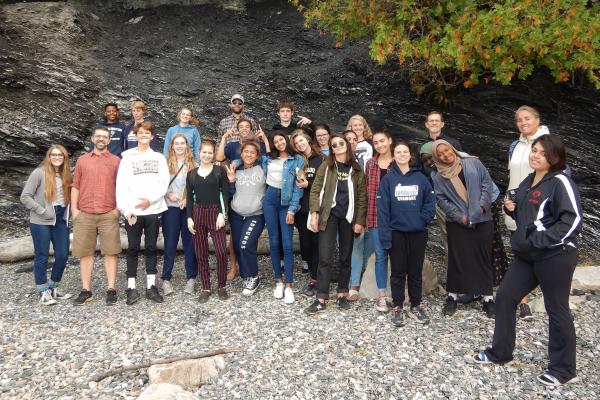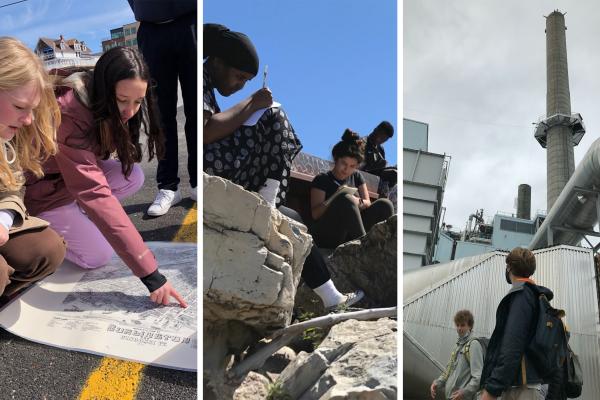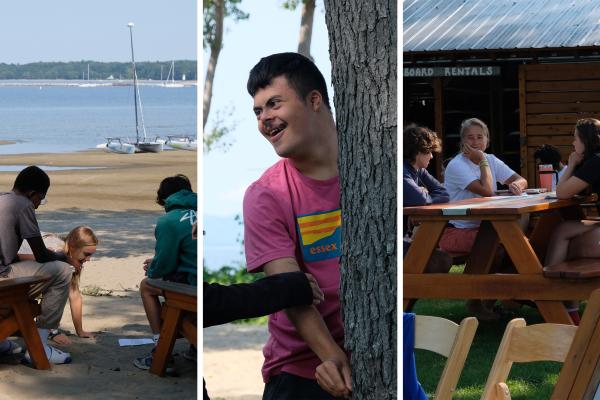Thank you for taking us on the journey of this amazing program, from the initial ideation phase, through to the successful execution. I love learning about how others turn their educational dreams into reality and what some of those necessary pieces are, to help bring it all together.
I am currently in the ideation phase to expand an educational, play based program focused on strengthening social/ emotional skills in young children and your journey has sparked several ideas about where to go from here. It can often be so daunting to go in another direction from what one had previously planned, and it’s extremely important to learn of others success stories when trying to do something out of the norm. Thank you, again, for providing the nudge I needed to pursue my educational dreams in a different way.
Educators, What's Your Dream?
What’s your dream as a teacher?
My dream was to design a challenging high school program that made students feel fully alive, empowered, and connected to their community. Sadly, I don’t know many young people who would describe their experience in high school with those adjectives.
But I knew about programs like that: Burr and Burton’s Mountain Campus; Vergennes’ Walden Project; City Term in New York City; the Maine Coast Semester in Wiscasset, Maine; the Mountain School in Vershire, Vermont; the Outdoor Academy in Pisgah Forest, North Carolina. Ask almost any graduate of these programs about their experience and they will start to glow. They will probably use the word love. You will feel them becoming more fully alive just in the remembering.
It’s not a coincidence that every one of these programs is deeply rooted in place. They ask students to look up from their screens and notice where they are. They invite students to reconnect to their senses – to hear the chickadee’s song or to feel the rough bark of a red pine tree or to see different architectural styles in a city block. The reawakening of the senses re-engages young peoples’ innate wonder and curiosity about their environment.
It’s also not a coincidence that these programs are immersive. They plunge students into new places and situations that won’t conform to a ninety-minute class block. Students and faculty milk cows before dawn and watch the sunset from a mountain peak. They plant a community garden on a rainy day and attend a poetry reading at night. They kindle a fire for warmth when the temperature dips below 50 – or even when it plummets to single digits. They cook brunch, scrub pots and clean toilets together.
Finally, these programs all cultivate community. They prioritize healthy relationships and create many avenues for open communication. They commit to regular community meetings or restorative circles. There is time to play together in the Farm Olympics, in impromptu folk bands, and in broomball tournaments. Meaningless and highly coveted prizes are imagined, created, and awarded. There is generous space for friendships to emerge and grow.
What happens when these conditions coexist? Everything becomes a part of the curriculum. Every moment of every day is a learning experience, and the academic curriculum is so intertwined and integrated within the day that it’s hard to tell where school begins and where it ends. The tyranny of the right answer is shattered. Students’ creativity comes alive in poetry and artwork – and even in expository writing. The boundaries between disciplines start to fade away: the ecology field trip to the bog turns into a discussion about natural climate solutions, and then in the van ride home, a debate breaks out about whether we should try to monetize ecosystem services or reject such a reductionist approach to sustainability. And then someone in the back seat discovers a spongy moth caterpillar climbing up their leg and freaks out, which becomes a memory that lasts a lifetime.
Alive. Empowered. Connected. That was my dream: to create a program that made students feel like that.
I shared my dream with everyone I could. And a funny thing happened. Almost everyone liked the idea, but for different reasons.
Teachers saw the potential to create a powerful and novel learning environment that would allow their creativity as educators to blossom. Students saw a vision of school that felt fresh, relevant, and energizing. Administrators saw a path to pilot some of their boldest ideas about transferable skill development, equity and inclusion. City leaders saw a way to engage and empower young people to take action in the community. Nonprofit partners saw an opportunity to reach students during the school day.
The momentum for my dream grew rapidly. It wasn’t even my dream anymore; it was becoming a shared dream, with like-minded educators Signe Daly, Peter McConville, and Dov Stucker on board. Now we needed to identify the partners who could turn it into reality: thought-partners and students to co-create with us; funders to meet a budget; administrators to commit to a pilot program. These pieces began to coalesce in early 2017, including a $40,000 grant from the Vermont Agency of Education.
The final piece of the puzzle was to find an organization that would nurture the project through a design and pilot phase. A highly collaborative organization well-versed in place-based education. Ideally, a partner with connections to Burlington schools and a history of successful program innovation.
Obviously: Shelburne Farms. Megan Camp and Alec Webb had already been thought-partners on the project and were immediately receptive. Jen Cirillo had already agreed to be on the BCL Steering Committee. And Peter McConville and Signe Daly, half of the brand-new BCL Project Team, were graduates of the Farm’s EFS Leadership Academy. It didn’t take long to reach an agreement for Shelburne Farms to be the Lead Community Partner for BCL.
What we created together, with help and input from literally hundreds of people in Visioning sessions and student consultancies and all manner of meetings, became known as the Burlington City & Lake Semester (BCL). It’s an immersive, place-based semester program focused on the places, people, problems, and possibilities of Burlington, offering four semester credits to Burlington High School juniors and seniors in English, Social Studies, and Applied Research. The class meets downtown all day, every other day, beginning with a Morning Meeting and then veering off into learning experiences of all kinds.
Gathering a diverse group of students was a core part of our vision and aligned with what we called our “Equity & Inclusion Roadmap.” We wanted to challenge the self-segregation and academic tracking that is so common in schools by enrolling a truly representative cross-section of students from BHS. As teachers, we also knew that studying the city would be a richer experience for everyone if we had different backgrounds and perspectives in our group, especially those of marginalized students. Most idealistically, we wanted to create a space where we could engage students in the kind of community-building work and play that grows deep relationships and that turns a group’s diversity into a strength. These goals were top of mind as we did student outreach and recruiting alongside our program design work.
We met every other day in the Youth Center at the Old North End Community Center, an ideal spot, except for the rickety pool table that took up a quarter of our floor space and the full-on construction project renovating (and rattling) the building all around us during our first year. But to our great benefit, we shared a hall with the Hindu Temple and Adult Learning English classes and the Senior Center; upstairs was AALV, supporting new American families settling in Vermont from all over the world; downstairs was a daycare and the Family Room, supporting parents and children from a wide variety of backgrounds. And Migmar Tsering, the building manager, born in Tibet, kept the whole place running smoothly. This building – and the people in it – immediately became an integral part of our curriculum. We were immersed in the diversity and dynamism of our community from the first day we walked in the door. “Everything,” Signe said approvingly, “is curriculum.”
Students immediately responded to the novelty and freedom and quirkiness of BCL and our new environment. We had big windows and a new carpet on the floor. We sat in a circle on two old couches, two large upholstered chairs, and a bunch of folding chairs, which always caused a lot of good-humored jockeying and animated discussion about fairness in seating arrangements. We had a toaster, a microwave, and a kettle, with a few boxes of tea bags and some serviceable mugs. We even had our own refrigerator, which prompted a few students to ask incredulously, “Can we put stuff in there?” (And we said, “Yes.”) There were no bells to start and end class periods. Nobody had to ask permission to go to the bathroom. The first few days, we included lots of games together, students and faculty, and we laughed out loud. Best of all, there was a palpable sense that we were all participating in a genuine experiment, the outcome of which was entirely unclear. It was exhilarating. The feeling of those first days of BCL was about as far away from “normal school” as it could be.
But it was school. It was school that had sprung to life. Maybe for the first time, we were asking students to be more than consumers of a curated school experience, with distinct classes divided up in binders. We were asking them to help us explore together what it means for a community to thrive; and we were doing our best to model what it could feel like for a community to thrive.
On our first afternoon, we took a City Walk together, breaking into four small groups and walking in different directions through the city. We asked students to make observations like anthropologists, to notice whether they saw signs that Burlington was thriving – or not thriving – and to jot down notes and questions in their journals. We stopped as a group frequently to discuss graffiti on a dumpster, expensive cars on the street, new yoga studios and run-down storefronts. Every conversation opened up interesting issues and questions. Some students were focused and attentive, scratching notes into their journals and chiming in with ideas. Others were mostly along for the walk, enjoying the freedom of being outside during the day. Some even complained about having to walk at all. As we walked along, in between our pauses, conversation bubbled up naturally. I listened as one student told me the story of her traumatic childhood and her journey through the foster care system. It might have taken me weeks or months to learn about her story in a traditional classroom setting, if I heard it at all.
I recall that our debrief of the first City Walk was imperfect – scattered, with too many faculty voices. We probably didn’t give enough time for students to write a closing journal entry. But the signal we had sent students was clear: their experiences in the City, rather than written texts, would be at the center of BCL. And a great deal of our learning would come from guided reflection on those experiences, in many different formats and settings. That alone was a radical reshaping of the expectations of school. Anything we came across during the day became fair game for discussion. There was no way to sit silently in the back of the room and watch the minutes tick by. We were moving through time and space together, on an unfolding adventure.
BCL 9 started this August. The program has won increased support from the Burlington School District and it’s on the path to permanent status as a program. But the moment that I knew BCL had hit our stride was in BCL 5, in the fall of 2020. In the depths of the pandemic, we met outside every day, fully masked, wrapped in fleece blankets or raincoats if needed. We shivered at the Surf Club on unusually cool September days; we huddled for warmth on the Sailing Center deck in October; we biked to the Intervale in the rain and journaled under tarps about our relationship with the natural world. We asked students to take the lead on projects about racial equity and climate resilience. And instead of complaining, kids thanked us for the most powerful learning experience of their high school journey.
I think BCL has delivered on the core elements of many of the other school programs that I admire so much. BCL has been a powerful vehicle to develop students’ sense of place. By walking in the city’s natural areas, students begin to learn the flora and fauna that characterize our natural communities and encounter our city’s unique conservation challenges. By learning about waterfront development, students begin to see evidence of geologic and climatic change, human land use patterns, and economic upheaval. Along the way, they find context for their lives that perhaps they didn’t understand before. Many students say BCL has transformed their appreciation of their hometown, reawakening their senses and their minds to what’s interesting about this place – and deepening their own sense of belonging here.
I believe BCL is strengthening the Burlington community. Each cohort of students, by working and learning and playing together – and participating in a regular Circle practice – seeks to build healthy relationships within their own group in ways that transcend the typical high school boundaries. In some ways, this carries over to the larger high school community. But BCL also creates conditions where adults and students can work in partnership, growing social capital in the community. Sometimes it leads to internships and jobs for BCL alumni; it often brings youth voice into city planning processes. If the health of a community is determined by the quality and range of its relationships, BCL has indeed helped Burlington thrive.
None of this would have been possible without Shelburne Farms as the lead partner for BCL. Dreams without structure and planning (and accounts payable capabilities) quickly fade. But Shelburne Farms’ capacity and strong leadership – and its living vision for the future – were the perfect match for the ambition behind BCL.
Through this odyssey, I have come to see that students and teachers thrive together. The founding faculty designed a program that could be a vessel for our own dreams. And our dreams include inviting students to be meaningful co-creators of the experience. This kind of shared ownership allows everyone to show up in the morning full of authentic curiosity and empowered to shape the day. We encourage each other to take intellectual risks and to stretch beyond our comfort zone to embrace the complexity of Burlington. We have fun together. We realize how lucky we are to encounter this inexhaustibly fascinating corner of the world. We become teachers and students inviting each other to live our dreams, and in so doing, participating in an education that matters.
So, I ask again: What’s your dream? Who might you share it with?
Andy Barker co-founded Burlington City and Lake and served as its project director for five years before recently transitioning to become a program officer with The Vermont Community Foundation. All of us at Shelburne Farms thank Andy for his vision and leadership.
